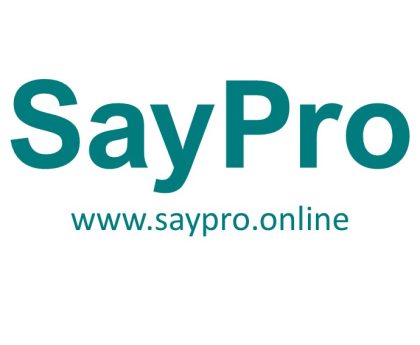SayPro Run penetration tests and report vulnerabilities on SayPro’s web systems from SayPro Monthly February SCMR-17 SayPro Monthly IT Services: Software development, cybersecurity, and IT support by SayPro Online Marketplace Office under SayPro Marketing Royalty
Overview
In February, the SayPro IT Security team conducted comprehensive penetration testing on SayPro’s web systems as part of ongoing efforts to strengthen the platform’s cybersecurity defenses. These tests are critical to identifying security weaknesses before they can be exploited by malicious actors, thereby safeguarding SayPro’s data integrity, user privacy, and operational continuity.
Penetration Testing Process
1. Scope Definition and Planning
- Identified key web applications and infrastructure components for testing, including the marketplace frontend, backend APIs, user authentication systems, and third-party integrations.
- Established clear rules of engagement to ensure tests do not disrupt live services or customer experience.
- Selected testing methodologies compliant with industry standards such as OWASP Top 10 and NIST cybersecurity guidelines.
2. Testing Methodologies Employed
- Automated Vulnerability Scanning:
Utilized tools like Burp Suite, Nessus, and OWASP ZAP to perform broad scans for common security issues such as SQL injection, cross-site scripting (XSS), and insecure configurations. - Manual Penetration Testing:
Conducted targeted manual testing by experienced security analysts to identify logic flaws, business process vulnerabilities, and chained exploit possibilities that automated tools might miss. - Authentication and Authorization Testing:
Tested for weaknesses in user login, session management, role-based access control, and potential privilege escalation. - API Security Testing:
Assessed REST and GraphQL APIs for exposure risks, improper input validation, and data leakage.
Findings and Vulnerabilities
- Critical Vulnerabilities:
- Identified a potential SQL injection vector in the product search endpoint.
- Detected session fixation vulnerabilities affecting certain legacy login flows.
- High-Risk Issues:
- Cross-site scripting (XSS) risks on user profile update forms.
- Insufficient rate limiting on authentication endpoints, increasing brute-force risk.
- Medium and Low-Risk Issues:
- Outdated third-party libraries with known security advisories.
- Minor information disclosure through verbose error messages.
Reporting and Remediation
- Created detailed vulnerability reports categorizing each finding by severity, impacted system, and suggested mitigation steps.
- Collaborated closely with the development team to prioritize fixes based on risk and business impact.
- Verified patch implementations through retesting to confirm vulnerabilities were resolved without introducing regressions.
Recommendations
- Immediate patching of critical and high-risk vulnerabilities within a 30-day window.
- Enhanced monitoring of authentication attempts to detect suspicious activity.
- Regular security training for developers emphasizing secure coding practices.
- Scheduled quarterly penetration tests to continuously assess security posture.
- Initiate a bug bounty program to crowdsource vulnerability discovery.
Conclusion
The penetration testing exercise has been instrumental in uncovering critical vulnerabilities in SayPro’s web systems, enabling proactive defense measures. These security assessments reinforce SayPro’s commitment to protecting user data, ensuring trust, and maintaining platform reliability.

